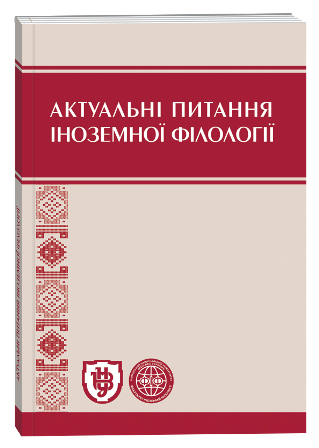METAPHORICAL ACTUALIZATION OF THE CONCEPT BETRAYAL DECEPTION SEGMENT IN MODERN ENGLISH
DOI:
https://doi.org/10.32782/2410-0927-2023-19-5Keywords:
concept, verbalization, conceptual metaphor, deception.Abstract
Language is one of the main tools of the surrounding world cognition and conceptualization. Modeling the concept content as a global mental unit involves the definition and analysis of linguistic means which objectify it. The structure of the concept contains conceptual, value and figurative components. The figurative component of the concept can include a vivid sensory representation (perceptual image), as well as a combination of conceptual metaphors that objectify the concept in language. The study of ways of the surrounding reality conceptualizing as a secondary reinterpretation does not lose its relevance given the fact that language as a way of accumulating knowledge and knowing the essence of a person is in the focus of modern scientific research. The analysis of the BETRAYAL concept metaphorical verbalization showed that the largest number of linguistic examples represent the «deception» segment. The conducted research made it possible to distinguish several thematic subgroups of the studied segment according to the methods of «false deeds and actions». Namely «deception-fraud» («deception-unfair trade», «deception-game», «deception-movement»), «deception-trickery», «deception-visualization» («deception-dazzle», «deception-illusion», «deception-restriction of visual contact», «deception-reincarnation»). The analyzed metaphors are formed with the help of nouns that determine representatives of the fauna – pig, pup, cat, pigeon, rook, prawn; somatisms – palm, teeth, eye, beard; blurriness – smoke, blear; clothing elements (headwear) – hood, caul, wool; artifacts – window-dressing, mirror. Verbs containing in their semantics semes to deprive of the ability to see – to blind, to make efforts – to draw, to pull; to move – to lead, to ride. The perspective of further research is the analysis of the investigated extralinguistic phenomenon verbalization in fiction discourse.
References
Великий тлумачний словник сучасної української мови : 250000. уклад. та голов. ред. В. Т. Бусел. Київ; Ірпінь: Перун, 2005. VIII, 1728 с.
Зацний Ю. А., Драбовська В. А. Концепт “automobile” у реалітивному просторі носіїв американського варіанта англійської мови та його репрезентація у сучасних навчальних тлумачних словниках англійської мови (на матеріалі фразових інновацій ХХІ століття). Нова філологія. 2017. № 71. С. 54–61.
Калько В. Вербальна репрезентація концепту діти в українських пареміях. Мовознавчий вісник. 2012. Вип. 14-15. С. 271–279.
Колегаєва І.М. Конструювання номінативного поля концепту: етапи та одиниці. Записки з романо-германської філології. Одеський національний університет імені І.І. Мечникова: ф-т романо-германської філології. Одеса: КП ОМД, 2018. Вип. 1 (40). С. 121–127.
Осіпчук Г.В. Вербалізація концепту ЇЖА в українських народних прикметах та пареміях. Актуальні проблеми філології та перекладознавства. 2019. Вип. 18. С. 44–47.
Приходько А.М. Концепти та концептосистеми в когнітивно-дискурсивній парадигмі лінгвістики. Запоріжжя: Прем’єр, 2008. 332 с.
Строченко Л.В. Вербалізація концепту GENIUS в афоризмах. Записки з романо-германської філології. 2019. Вип. 1. С. 107–112.
Cambridge Dictionary. URL: http://dictionary.cambridge.org
Collins English dictionary. URL: https://www.collinsdictionary.com
The Free Dictionary by Farlex. URL: http://www.thefreedictionary.com
Macmillan English Dictionary. URL: http://www.macmillandictionary.com
Oxford living dictionaries. Oxford University Press, 2020.
URL: https://en.oxforddictionaries.com
Wilkinson P. R. Thesaurus of Traditional English Metaphors. 2006. 2034 p.
Complete Works of Geoffrey Chaucer: Boethius and Troilus p 479https://books.google.com.uahttps://books.
google.com.ua







